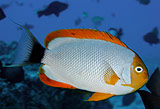
French Frigate Shoals
(Kānemiloha‘i)
French Frigate Shoals is an open atoll consisting of a large, crescent-shaped reef surrounding numerous small, sandy islets. While the land area is only 1⁄4 square kilometer (67 acres), the total coral reef area of the shoals is over 938 square kilometers (232,000 acres).
 French Frigate Shoals exhibits the classic features of a well-developed coral atoll. The coral growth is atop an eroded volcano, which has been submerged for millions of years. A steep-sided basalt pinnacle juts out of the water in the center of the atoll. This unique rock formation is the last remnant of the original volcano. The pinnacle was named "La Pérouse Pinnacle" after Compte de La Pérouse, who visited the atoll in 1786. In the moonlight the pinnacle so resembled a full-rigged sailing ship that it lured more than one vessel to her doom on the shoals as Captains investigated the unidentified companion.
French Frigate Shoals exhibits the classic features of a well-developed coral atoll. The coral growth is atop an eroded volcano, which has been submerged for millions of years. A steep-sided basalt pinnacle juts out of the water in the center of the atoll. This unique rock formation is the last remnant of the original volcano. The pinnacle was named "La Pérouse Pinnacle" after Compte de La Pérouse, who visited the atoll in 1786. In the moonlight the pinnacle so resembled a full-rigged sailing ship that it lured more than one vessel to her doom on the shoals as Captains investigated the unidentified companion.
 Tern Island, a part of the atoll, was formed into a runway to serve as a refueling stop for planes enroute to Midway during World War II. The original seawall, runway, and some of the buildings remain. The U.S. Fish and Wildlife Service continues to maintain a field station there, which is staffed year-round by two permanent employees and a handful of volunteers.
Tern Island, a part of the atoll, was formed into a runway to serve as a refueling stop for planes enroute to Midway during World War II. The original seawall, runway, and some of the buildings remain. The U.S. Fish and Wildlife Service continues to maintain a field station there, which is staffed year-round by two permanent employees and a handful of volunteers.
The reef system associated with French Frigate Shoals supports the greatest variety of coral species in the NWHI with forty one species of stony corals documented. These include table, finger, and lobe corals. Table corals of the genus Acropora, which are common throughout reefs of the central and south Pacific, are essentially absent in the Main Hawaiian Islands (MHI) but are common at FFS. The chevron butterflyfish (Chaetodon trifascialis), which feeds exclusively on polyps of Acropora corals, is likewise absent in the MHI but common at FFS. It also supports more than 600 species of invertebrates such as sponges, coral worms, snails, lobsters, crabs, shrimps and clams, oysters, sea urchins, and sea stars. Many of which are endemic species.
 More than 150 species of algae live among the reefs, including red, green and brown algae. Especially diverse and lush algal communities are found immediately adjacent to La Perouse Pinnacle, leading phycologists (algae scientists) to speculate that influx of additional nutrients in the form of guano are responsible for the high algal productivity in this habitat.The outer reef waters support gray reef sharks, butterfly fish, and large schools of jacks and groupers. Endemic masked angelfish (Genicanthus personatus) are occasionally seen here at scuba diving depths. In the Main Hawaiian Islands, they are rarely seen shallower than 300 feet.
More than 150 species of algae live among the reefs, including red, green and brown algae. Especially diverse and lush algal communities are found immediately adjacent to La Perouse Pinnacle, leading phycologists (algae scientists) to speculate that influx of additional nutrients in the form of guano are responsible for the high algal productivity in this habitat.The outer reef waters support gray reef sharks, butterfly fish, and large schools of jacks and groupers. Endemic masked angelfish (Genicanthus personatus) are occasionally seen here at scuba diving depths. In the Main Hawaiian Islands, they are rarely seen shallower than 300 feet.
 Hundreds of green sea turtles inhabit French Frigate Shoals. Over 90% of the threatened Hawaiian population of green sea turtles travel to the shoals for safe nesting. Satellite tagging of these turtles indicates that most of them migrate to the Main Hawaiian Islands to feed and reach sexual maturity before returning to French Frigate Shoals to breed. Some of these turtles travel northwest to feed, while others travel as far south as Johnston Atoll.
Hundreds of green sea turtles inhabit French Frigate Shoals. Over 90% of the threatened Hawaiian population of green sea turtles travel to the shoals for safe nesting. Satellite tagging of these turtles indicates that most of them migrate to the Main Hawaiian Islands to feed and reach sexual maturity before returning to French Frigate Shoals to breed. Some of these turtles travel northwest to feed, while others travel as far south as Johnston Atoll.
The many small islets of French Frigate Shoals provide refuge to the largest sub-population of endangered Hawaiian monk seals. Preserving this atoll is critical to their survival.


